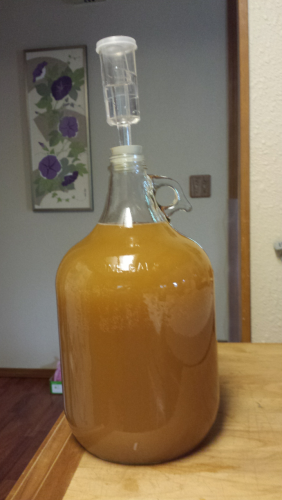Gluten Free Home Brewing Blog
Brew In A Bag: Brew Day Notes To Self
We are not unfamiliar with the Brew In A Bag (BIAB) brewing method, we just had not actually brewed beer this way before. We have read up on a lot of brewing topics in order to be knowledgeable for customer questions and our own curiosity. However, we have not yet had time to try everything we have read at least once. We try to incorporate a couple new concepts or try new ingredients into every batch of beer we brew.
There were more lessons to be learned than we anticipated going into this batch of beer. Some lessons learned were do to the changes we made to our brewing equipment. Our plan was to make enough wort to ferment two separate one gallon batches. We wanted to do this because we were going to compare fermentation using an aeration system to vigorous agitation. We took the false bottom out of our 10 gallon cooler mash tun in placed it in an 8 gallon brew kettle. We wanted to use a false bottom because we anticipated needing to turn on the heat source to maintain the target mash temperature. We used the Brew In A Bag nylon steeping bag to hold the grain bill.
Using a BIAB calculator we calculated the total strike water volume and strike water temperature. We used the grain absorption default numbers in the calculator. We had never given grain absorption much thought because with other brewing methods we could always just use more sparge water. But the BIAB method does not involve sparging the grains, so this particular number value is as important to BIAB brewing as achieving the perfect target mash temperature is when using a cooler mash tun. We will get back to whether our math was correct in a little bit.

(Hefeweizen BIAB recipe - pictured)
Because we were brewing essentially a half batch, we decided to use our kitchen stove top. We use it all the time for canning and even have the optional raised burner so that when you are canning you do not scorch the top of the stove. We thought, no problem, we got this. Not so, we had difficulty achieving a rolling boil because we have never boiled this volume of liquid before and often got too hot or too cold of a burner temperature. And to answer your question, yes, this is an electric stove! At this point we were really missing our propane gas burner we normally use on brew day. We think the poor boil attributed to the large amount of trub we had when we transferred from primary to secondary fermentation.
Now lets get back to the grain absorption default number we used to calculate our total strike water volume. It was low, like way low. The default value assigned was 0.045 gallons of water per pound of grain. After a quick google search we found recommendations ranged from 0.125 to 0.2 gallons/pound. By the time we racked into the secondary fermenter our 2.25 gallon target wort volume was down to a gallon. However, this does include the exceptionally large amount of trub we had in both the brew kettle and primary fermenter. What we did not learn from this lesson was whether the gluten free malts absorb more or less water as compared to conventional malts. For our next batch, which will be this same recipe, we are leaning towards the 0.2 gallons/pound as to not short ourselves again. Once we get the gallons/pound ratio dialed in we will certainly share that information with all our fellow GFHBers!
Until our next BIAB blog post...cheers!